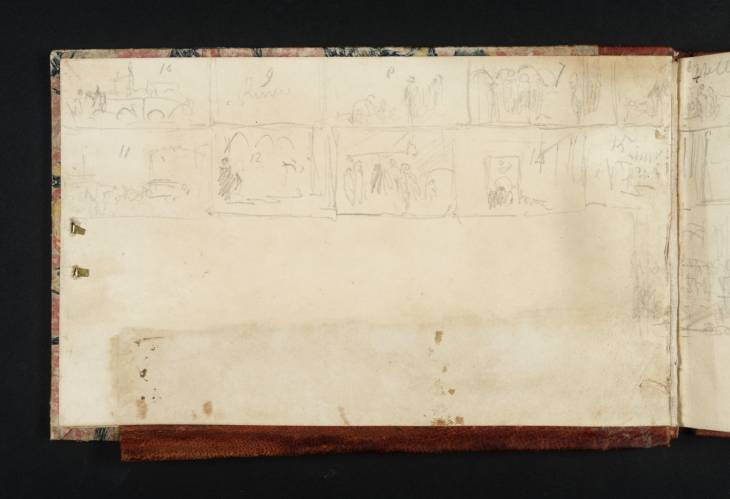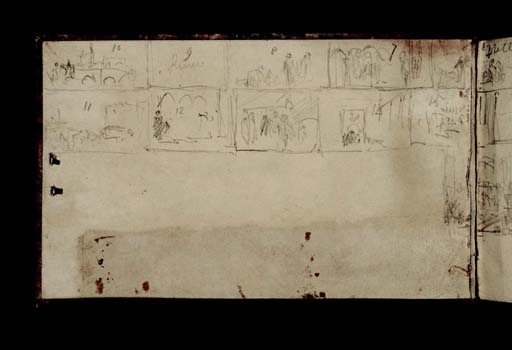Joseph Mallord William Turner Designs for the 'Royal Progress' Series 1822
Image 1 of 2
Inside back cover of sketchbook
Joseph Mallord William Turner,
Designs for the 'Royal Progress' Series
1822
(Inside back cover of sketchbook)
Joseph Mallord William Turner 1775–1851
Inside Back Cover:
Designs for the ‘Royal Progress’ Series 1822
D40980
Turner Bequest
Turner Bequest
Pencil on white wove paper, 111 x 188 mm
Inscribed in pencil by Turner, top row of sketches from left to right ‘10 9 8 7’, lower row ‘11 12 13 14 15’
Inscribed in pencil by Turner, top row of sketches from left to right ‘10 9 8 7’, lower row ‘11 12 13 14 15’
Accepted by the nation as part of the Turner Bequest 1856
References
1909
A.J. Finberg, A Complete Inventory of the Drawings of the Turner Bequest, London 1909, vol.I, p.614, as ‘inside of end cover’.
1981
Gerald Finley, Turner and George the Fourth in Edinburgh 1822, exhibition catalogue, Tate Gallery, London 1981, pp.[247], [259] reproduced.
2006
Andrew Wilton, Turner in his Time, revised ed., London 2006, p.124.
1984
Martin Butlin and Evelyn Joll, The Paintings of J.M.W. Turner, revised ed., New Haven and London 1984, pp.153–4.
With the sketchbook inverted, the inside back cover has been used for the continuation of a series of sketches that have been identified as making up an unrealised plan for a ‘Royal Progress’ series of paintings.1 The designs are numbered ‘1’–‘18’, and there is also an unnumbered nineteenth composition. Numbers ‘1’–‘6’ and ‘16’–‘18’ along with the final design are on folio 43 verso (D40979). (The entry for which also contains an introduction to the whole series; see also the George IV’s Visit to Edinburgh 1822 Tour Introduction for more information.)
The designs on this page begin at the top right with ‘7’ and follow right to left in the top row, continuing left to right until composition ‘15’ on the lower row.
Gerald Finley has tentatively identified composition ‘7’ as ‘The ceremony of the Regalia’ (see also Tate D17564; Turner Bequest CC 36). This was a ceremony that took place in Holyrood Palace shortly after George IV’s arrival on 15 August. While there is no arcading in the castle, Finley suggests that the arch shapes may be ‘gilded moulding’. However descriptions of the appearance of the chamber used as the throne room do not fit the appearance of this sketch. As Finley points out, Turner may have drawn the scene from his imagination, and as there are no sketches of the room or event from life this is certainly plausible. Alternative identifications are Finley’s suggestion of the receiving of the keys outside Holyrood (as in composition ‘6’) , the interior of St Giles’s as in composition ‘15’ and two sketches in the King’s Visit to Edinburgh sketchbook (Tate D17559; Turner Bequest CC 33a), or the supper room extension to the Assembly Rooms during the Peers’ Ball (see Tate D17585; Turner Bequest CC 47). The final two possibilities would, however, be out of chronological sequence.
Composition ‘8’ shows several figures, one kneeling at the left and several more standing with their backs to us at the right. Finley tentatively suggests that this may represent the Royal Levée which took place at Holyrood on 17 August, where the King sat enthroned, while presentations where made to him.2 Robert Mudie’s account explains: ‘In compliment to the country, his Majesty appeared in complete Highland costume, made of royal Stuart tartan, which displayed his manly and graceful figure to great advantage.’ Each member of the company, ‘on his name being announced, made his approach, knelt, kissed the hand of the King, and withdrew [...] about fifteen were presented in a minute.’3 Turner made no further sketches or studies of the event.
The box labelled ‘9’ contains no drawing, only the word ‘Review’ which Finley notes:
probably refers to the military display of volunteer cavalry and yeomanry at Portobello Sands witnessed by the King. As it would have been impossible for Turner to have made an intelligible record of this subject on the minute scale of these compositions, the word ‘Review’ must have been adequate to remind him of this particular event.4
Perhaps for the same reason there are no on-the-spot sketches of the military review. Finley does identify one view of Edinburgh from Arthur’s Seat as the procession to or from the review, though, as has been suggested, this may in fact represent the cavalcade arriving at Holyrood (Tate D40979; Turner Bequest CCI 43a). The subject is out of sequence as it took place on 23 August, after the regalia procession of composition ‘11’.
Finley is unable to suggest a subject for composition ‘10’, which, he notes, ‘seems to have been associated with a bridge, perhaps the old North Bridge.’5 One possibility is that it is, like composition ‘11’, also shows the procession to Edinburgh Castle with the Regalia of Scotland on 22 August. The procession did not, in fact cross over North Bridge, but did arrive at the castle via the Royal Mile, and return by Princes Street, which are either side of the bridge. Another possibility is that it does not show a bridge at all. Instead the bridge shape could be created by the parapet and cannon embrasures in the Half Moon Battery of Edinburgh Castle. There are a number of sketches of the arrival of the procession from the castle, one of which is comparable, though not identical, to the present composition (Tate D17604; Turner Bequest CC 56a). This comparison suggests that the vertical line above the left arch in composition ‘10’ could be the flag pole that is shown in the sketch, and the square shapes at the upper left and right could stand in for the buildings on either side of the Royal Mile. Although Turner later selected an alternative view of the procession for his vignette illustration to the first volume of the 1826 Provincial Antiquities publication (Tate D13748; Turner Bequest CLXVIII A) (composition ‘11’), his original plan was to make a view from the castle. Compositions ‘10’ and ‘11’ show that he either considered representing the event with two pictures, or considered two alternatives.
Composition ‘11’ therefore represents a second version of the procession with the Regalia subject. This view is taken from the Castle Esplanade and looks up to the Half Moon Battery; it was the basis for the Provincial Antiquities design mentioned above. Based on this final design, Finley regards the study as representing ‘the concluding moments of the event: the dramatic moment when the King waved to the crowds from the Half Moon battery, while the castle’s cannons boomed a salute.’ He also points out that ‘Turner’s vignette may have been inspired by Skene’s watercolour of the same subject’:6 James Skene, King George IV at Edinburgh Castle, circa 1822 (Edinburgh City Libraries). William Home Lizars also produced a very similar view.7 (See also composition ‘14’.)
Compositions ‘12’, ‘13’ and ‘14’ are all very tentatively identified by Finley as relating to the ceremony of the return of the Regalia to the castle on 24 August,8 an event that Turner did not make on-the-spot sketches of. He suggests that ‘12’ may show ‘the removal of the Regalia from the Throne Room of the palace’ of Holyrood. As in composition ‘7’, the problem of whether or not a picture with arcading can be regarded as depicting Holyrood is an issue, and Finley thus suggests the interior of St Giles’s as an alternative, noting that this would put the subject out of sequence. As in ‘7’, the Assemble Room extension must be considered as another possibility.
Finley proposes the deposition of the Regalia in the crown room of Edinburgh Castle for composition ‘13’. The composition seems to show a group of figures lining up to process through an archway. ‘14’, Finley notes, depicts an arch that is suggestive of ‘the entrance gate of the castle’, and may therefore show the procession with mounted troops entering the castle with the Regalia. There are therefore compositional similarities to the volume 1 Provincial Antiquities vignette.9
Composition ‘15’, which continues slightly onto folio 43 verso is too slight and vague to appear to be of anything at all. However, according to the chronology of subject, and the importance given to Turner’s only finished oil painting to result from the sequence, Finley suggests this is most likely to be the service at St Giles’s on 25 August (see Tate D17559; Turner Bequest CC 33a), the subject of Turner’s painting, George IV at St Giles, Edinburgh, circa 1822 (Tate N02857),10 perhaps with the pulpit represented by two vertical lines at the left and the arches by a series of vertical lines in the centre. The only other subject to fit the chronology is the Provost’s Banquet at Parliament House, but seeing as Turner added a rather more carefully delineated version at the end of the sequence, this is less likely.11
Thomas Ardill
November 2008
How to cite
Thomas Ardill, ‘Designs for the ‘Royal Progress’ Series 1822 by Joseph Mallord William Turner’, catalogue entry, November 2008, in David Blayney Brown (ed.), J.M.W. Turner: Sketchbooks, Drawings and Watercolours, Tate Research Publication, December 2012, https://www


